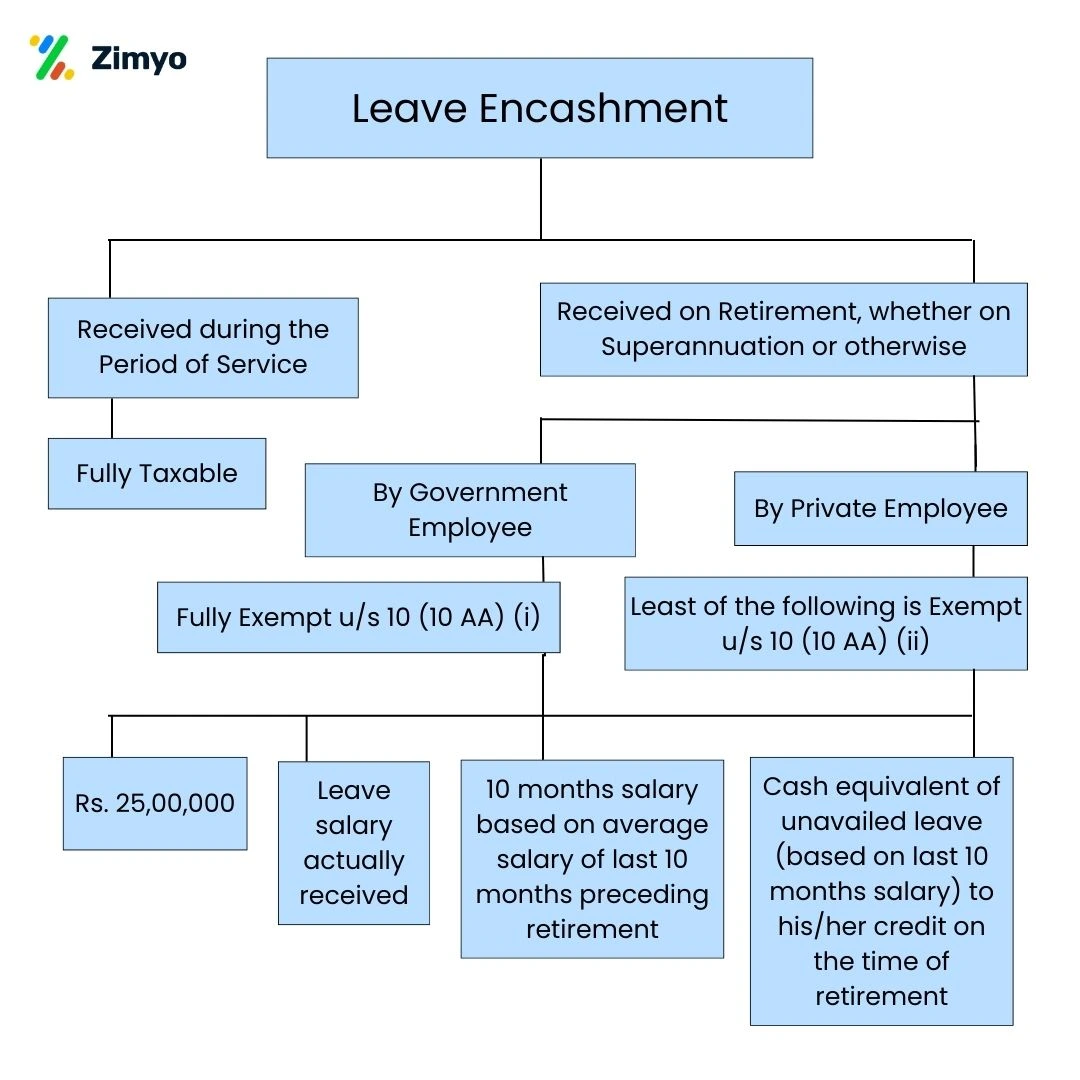
Calculate your leave encashment in a click! Know the detailed Leave encashment received from your employer.
Home » Resources » Calculators » Easy To Use Leave Encashment Calculator
| Particulars | Amount |
|---|---|
| Last drawn Basic Salary + DA | ₹ 0 |
| Unutilised leave after retirement | 0 leave |
| Leave Encashment recieved | ₹ 0 |
The leave encashment calculator is an online tool. It helps you determine the exempted and taxable leave salary for income tax purposes. The calculator determines how much an employee can receive for accrued but unused leave and checks its taxable amount. This calculator simplifies the process and eliminates manual errors.
Leave encashment refers to the payment employees receive for their unused leaves. It typically forms part of the Full and Final Settlement (FnF) during resignation or retirement.
|
Type of Leave |
Description ( varies across companies) |
Encashment Eligibility |
|
Short-term leave used for personal reasons. |
Often eligible for encashment, varies by company. |
|
|
Earn leave / Privilege leave |
Pre-approved leave for personal or professional purposes. |
Eligible after a certain period. |
|
Leave taken for health reasons. |
Short-term leaves may be encashed; long-term are not. |
|
|
Paid leave for skill development through courses or certifications. |
Often reimbursed and eligible for encashment. |
|
|
Holiday Leaves |
Paid leaves for holidays declared by the organization. |
Generally eligible for encashment. |
|
Leave for pregnant employees, spanning 12-26 weeks. Extended leaves are not eligible for encashment. |
Standard leave period is paid and encashable. |
The Leave encashment formula is as follows:
Leave Encashment = Unused Leave Days × Daily Salary
Daily Salary = (Basic Salary + Dearness Allowance) ÷ 30
Mr. X is retiring after “15 years” of service.
Daily Salary = ₹30,000 ÷ 30 = ₹1,000
Leave Encashment = 175 days × ₹1,000 = ₹1,75,000
The leave encashment calculator simplifies the process.
Step 1: Enter the basic salary and dearness allowance.
Step 2: Enter the number of earned leaves available.
Step 3: The calculator displays the amount of leave encashment.
Leave encashment is taxable, but the tax implications can vary based on the type of employee and the circumstances under which the leave encashment is received. For public sector employees, leave encashment is fully exempt from tax, providing a significant benefit at the time of retirement.
On the other hand, for private employees, leave encashment is partially taxable. The current tax exemption limit for private employees is set at ₹25,00,000. To claim tax relief, private employees can utilize Section 89 of the Income Tax Act and must fill out Form 10E. Understanding these tax implications can help employees plan better for their financial future and make informed decisions about their leave encashment.

Under Section 10 AA of the Income Tax Act, earned leave encashment cannot exceed 30 days for every year of service. Taxability depends on:
When any kind of leave is encashed by the employee one can avail certain partial and full exemptions. The conditions of exemptions are:
To make the most of your leave encashment, consider these tips:
Check your company’s leave policy: Every organization has different rules regarding leave encashment.
Plan your leaves wisely: If your employer offers encashment at the end of service, ensure you collect leave accordingly.
Understand tax implications: Being aware of tax exemptions can help you optimize your financial benefits.
Understanding your company’s leave encashment policy is crucial for effective leave and financial planning. Each organization may have different rules, so it’s important to be aware of your specific company’s policy to make the most of your leave benefits.
Whether you’re encashing leave while in service or at retirement, knowledge of the leave encashment formula and taxability can help you make better financial decisions. Use a leave encashment calculator to estimate your benefits and plan accordingly.
I was able to implement the platform on my own. It helps in assigning the tasks to other employees, conducting surveys and polls, and much more. The ease of use and self-onboarding is something that I would like to appreciate.
Sonali, Kommunicate
Zimyo simplifies attendance management for our organization. The leave and attendance are so streamlined that we have never faced any difficulties with the system.
Anurag, Eggoz Nutrition
In order to calculate the leave encashment you can use the formula
(Basic Salary+ Dearness Allowance)/30* Number of Earned Leaves
First, add the Basic salary and Dearness Allowance, then divide the sum by 30. Next, multiply the quotient by the number of days of Earned Leave, which should not exceed 300 days.
You can either encash or clear your annual leave if your employment was terminated. If the unused leave is encashed, it should be calculated at the gross rate of pay based on your last drawn salary.
“I was able to implement the platform on my own. It helps in assigning the tasks to other employees, conducting surveys & polls & much more. The ease of use & self-onboarding is something that I would like to appreciate.”


